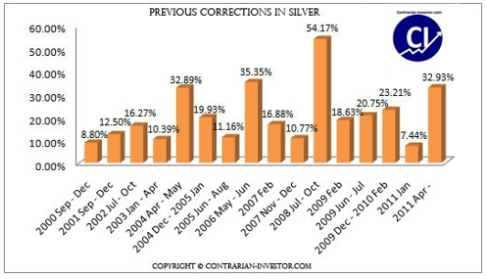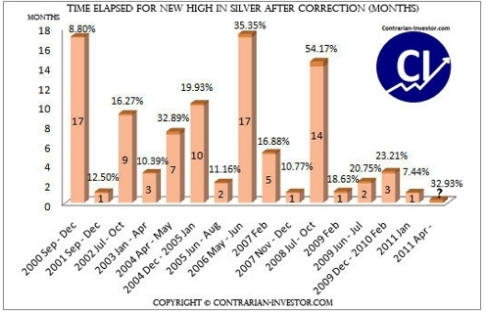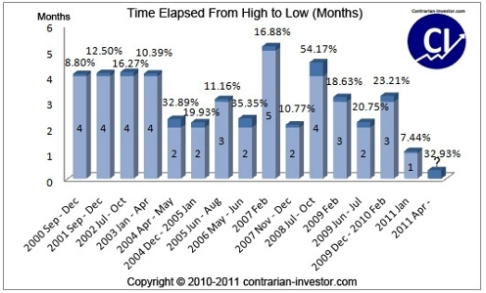A look at how far silver might correct
 A correction in silver prices is now under way after an almost parabolic move. Silver prices reached a high of $49.79 on April 25, and quickly pulled back and plunged to a low $32.65 on May 12, shedding 32% of gains made in recent months.
A correction in silver prices is now under way after an almost parabolic move. Silver prices reached a high of $49.79 on April 25, and quickly pulled back and plunged to a low $32.65 on May 12, shedding 32% of gains made in recent months.
More or less all commodities had been outperforming the rest of the market, partially due to loose monetary policies and low interest rates, but silver in particular was one of the leaders gaining over 77% between February, and the end of April. In addition, the Silver market has been in backwardation and supply constraints were evident among physical products as big investors including Eric Sprott were taking record amounts in delivery.
After a two year run up in prices, the correction in silver was followed by a pullback of commodities across the board including gold, oil, and copper. The correction in silver may have been exacerbated by an unprecedented number of margin hikes in silver future contracts. The CME Group increased margin requirements for future traders by 5 consecutive margin hikes within two weeks, resulting in an 84% increase in margin requirements.
How far will silver correct?
We don’t know for sure how far silver will correct. It already made a 32% correction and erased all gains since March, 2011. To help answer this question it may be helpful to look at previous corrections. The chart shows any meaningful corrections since 2000 when the Bull Market began. The current correction is rather significant and has only been matched by three other corrections over the last 10 years. The steepest correction was by far in 2008, during the financial meltdown, which caused silver to correct by more than half.
How long will this correction last?
Silver trades in a thin market, which results in high volatility and large prices swings. Previous corrections have lasted between a month to well over a year. The chart shows how long it took for silver to make a new high after a correction. It has previously taken anywhere between 7 months to 17 months for silver to make new highs after similar magnitude corrections. Although the past is not indicative of the future it may provide us with some guidance.
When will a bottom be established?
During previous corrections it has taken anywhere from 1 to 5 months for the market to find a bottom. The chart compares the size of each previous correction with the time elapsed for a bottom to have been reached. A 2 to 4 month period seems to be the average.
Despite a significant correction in silver prices the long term outlook is still very bullish. It is important to remember that the fundamentals that have been driving the market are still intact. We still will have record deficits, a weakening dollar and a horrendous debt problem that is not going away. In addition, limitations of supply of physical silver persist, and backwardation has widened to almost a dollar according to James Turk.
This correction has presented a buying opportunity for investors who felt that they were being priced out of the market with silver close to $50. SLV and SLW in addition to physical metal are all attractive silver plays.
iShares Silver Trust (SLV) is one of the most popular silver ETF’s. The trust holds physical silver in a custodian bank, and is designed to reflect the price of silver on the market less expenses and liabilities. Although you are subject to the risk of relaying on a custodian to actually hold your silver, this EFT is a very cost efficient instrument and an excellent trading vehicle.
Silver Wheaton Corp. (SLW) is a mining company and the largest metals streaming company in the world. It generates its revenue primarily from the sale of silver. It buys streams at low fixed prices and sells the metal at market prices. The streaming strategy allows the company to significantly reduce its operating costs, and keep its capital expenditures at a minimum, while still having access to a large amount of silver. The company at present has fourteen silver purchase agreements and two precious metals agreements where, in exchange for an upfront payment, it has the right to buy all or a part of the silver production, at a low fixed cost, from high-quality mines located in various geographical regions. In 2010, the company generated sales of $423 million, and with an impressive 69% margin, SLW made $290 million in net income. As the price more than tripled since its low last year the current correction may present a buying opportunity in to this very profitable company.
Disclosure: I have no positions in any stocks mentioned, and no plans to initiate any positions within the next 72 hours.
More News
{{ commodity.name }}
{{ post.title }}
{{ post.date }}




Comments